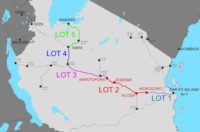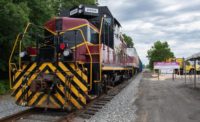A joint venture of Portuguese and Turkish construction firms has been awarded a $1.2-billion contract for a new 202-kilometer, single-track, 1,435-millimeter-gauge railway line, in Tanzania. The segment is part of the 1631-km Dar es Salaam-Isaka-Kigali and Keza-Musongati railway project connecting the country to neighboring Burundi and Rwanda.
Tanzania’s Railway Assets Holding Co.—a state-controlled agency for the acquisition, development and management of railway infrastructure—in February picked the JV of Portugal's Mota-Engil, Engenharie & Construcao Africa SA and Turkey's Yapi Merkez Insaat Ve Sanayi for this first phase, which will link Dar es Salaam to Morogoro. The 30-month contract starts at the end of March.
Although 40 firms requested tender documents, only the Portuguese-Turkish JV returned them.
The 202-km segment is part of the first 970 km, which will run from Dar es Salaam port to Isaka, in northern Tanzania; it will be constructed parallel to the existing 1,000-mm-gauge line. A new 494-km line will be built between Isaka and Rwanda’s capital, Kigali. Another 197-km line will run off the Isaka-Kigali stretch, at Kega, through Gitega to Musongati, in Burundi.
At least 1383 km of the modern rail will be in Tanzania, while Rwanda and Burundi will each have 197 km. The entire rail project has four phases, which will be constructed over three years. Last year, China EXIM bank signed an agreement with Tanzania for a $7.6-billion concessional loan for the project. Further, Tanzania has allocated $500 million for the new line in this fiscal year.
In 2015, Tanzania picked a China Railways Materials-led consortium for a build-operate-transfer contract, which last year was annulled because of allegations of impropriety at the tendering stage after a new government came into office.
Three more tenders for the remaining part of the railway line will be announced in April.
The railway has been designed primarily for freight, with permissible axle loads of 32.4 tons. The line will have ballasted track, with heavy rail of 70 kilograms per meter and prestressed sleepers with elastic fasteners. Freight trains up to 2,000 m long will be capable of speeds of up to 160 km per hour, and projections indicate the line will handle 8.5 million tons per year by 2029.






